Research on Collaborative Governance of Cross-Domain Digital Innovation Ecosystems Based on Evolutionary Game Theory
Abstract
1. Introduction
2. Literature Review
2.1. Digital Innovation Ecology
2.1.1. Digital Innovation
2.1.2. Digital Innovation Ecosystems
2.2. Evolutionary Games
2.3. Collaborative Governance
2.4. Literature Commentary
3. Governance Actor Analysis
3.1. Governance Constituents
3.2. The Relationship Between Governance Actors
4. Evolutionary Game Model Construction
4.1. Model Assumptions and Variable Descriptions
4.2. The Construction of the Tripartite Payoff Matrix
4.3. Replication of Dynamic Equation Building
5. Stability Analysis
5.1. Stability of Governance Decisions
5.2. An Analysis of the Stability of Governance Decision-Making in Digital Platform Enterprises
5.3. An Analysis of the Stability of Governance Decision-Making Among Stakeholders
5.4. An Analysis of the Stability of the Overall System Evolution Strategy
6. Simulation Analysis
6.1. Establishment of System Dynamics Models
6.2. Initial Evolutionary Pathway Analysis
6.3. The Impact of Changes in Government Punitive Mechanisms
6.4. The Impact of Digital Platform Enterprises on the Collaborative Governance of Cost and Revenue Fluctuations
6.5. The Impact of Changes in Internal Incentive Mechanisms
6.6. Results and Discussion
7. Conclusions and Recommendations
8. Limitations and Future Directions
Author Contributions
Funding
Data Availability Statement
Conflicts of Interest
References
- Nambisan, S.; Lyytinen, K.; Majchrzak, A.; Song, M. Digital innovation management. MIS Q. 2017, 41, 223–238. [Google Scholar] [CrossRef]
- Goldfarb, A.; Tucker, C. Digital economics. J. Econ. Lit. 2019, 57, 3–43. [Google Scholar] [CrossRef]
- Yoo, Y.; Henfridsson, O.; Lyytinen, K. Research commentary—The new organizing logic of digital innovation: An agenda for information systems research. Inf. Syst. Res. 2010, 21, 724–735. [Google Scholar] [CrossRef]
- Chae, B.K. A General framework for studying the evolution of the digital innovation ecosystem: The case of big data. Int. J. Inf. Manag. 2019, 45, 83–94. [Google Scholar] [CrossRef]
- Wei, J.; Zhao, Y. Governance mechanisms of digital innovation ecosystems. Sci. Res. 2021, 39, 965–969. [Google Scholar]
- Senyo, P.K.; Liu, K.; Effah, J. Digital business ecosystem: Literature review and a framework for future research. Int. J. Inf. Manag. 2019, 47, 52–64. [Google Scholar] [CrossRef]
- Sun, Y.; Zhu, R.; Song, J. Research on the Evolution and Governance of Digital Innovation Ecosystems. Stud. Hist. Sci. 2023, 41, 325–334. [Google Scholar]
- Chen, M. Innovation in Data Element Circulation Mechanisms to Break Down “Data Silos” and Unlock Data Value. Commun. World 2024, 6, 21–24. [Google Scholar]
- Chen, Y.; Wang, X.; Li, L. Research and Progress on Traffic Situation Awareness Enhanced by Social Media Data. J. Intell. Sci. Technol. 2022, 4, 1–13. [Google Scholar]
- Guo, Q.; Tian, Y. A Privacy Protection Scheme for Controlled Sharing of Medical Data. J. Xi’an Univ. Electron. Sci. Technol. 2024, 51, 165–177. [Google Scholar]
- Nambisan, S.; Wright, M.; Feldman, M. The digital transformation of innovation and entrepreneurship: Progress, challenges and key themes. Res. Policy 2019, 48, 103773. [Google Scholar] [CrossRef]
- Boland, R.J., Jr.; Lyytinen, K.; Yoo, Y. Wakes of Innovation in Project Networks: The Case of Digital 3D Representations in Architecture, Engineering, and Construction. Organ. Sci. 2007, 18, 631–647. [Google Scholar] [CrossRef]
- Fichman, R.G.; Dos Santos, B.L.; Zheng, Z. Digital innovation as a fundamental and powerful concept in the information systems curriculum. MIS Q. 2014, 38, 329–354. [Google Scholar] [CrossRef]
- Abrell, T.; Pihlajamaa, M.; Kanto, L.; Brocke, J.V.; Uebernickel, F. The role of users and customers in digital innovation: Insights from B2B manufacturing firms. Inf. Manag. 2016, 53, 324–335. [Google Scholar] [CrossRef]
- Yoo, Y.; Boland, R.J., Jr.; Lyytinen, K.; Majchrzak, A. Organizing for innovation in the digitized world. Organ. Sci. 2012, 23, 1398–1408. [Google Scholar] [CrossRef]
- Bharadwaj, A.; El Sawy, O.A.; Pavlou, P.A.; Venkatraman, N.V. Digital business strategy: Toward a next generation of insights. MIS Q. 2013, 37, 471–482. [Google Scholar] [CrossRef]
- Zhen, J.; Shi, B.; Zhang, X. The Synergistic Effects and Dynamic Evolution Forecast of China’s Digital Innovation and High-Quality Economic Development. Mod. Financ. J. Tianjin Univ. Financ. Econ. 2023, 43, 3–20. [Google Scholar]
- Hong, J.; Zhang, S. The Driving Mechanisms of Digital Innovation in Manufacturing from the Perspective of Resource Availability Theory. J. Sci. Res. 2024, 42, 405–414+426. [Google Scholar]
- Beltagui, A.; Rosli, A.; Candi, M. Exaptation in a digital innovation ecosystem: The disruptive impacts of 3D printing. Res. Policy 2020, 49, 103833. [Google Scholar] [CrossRef]
- Adner, R. Ecosystem as structure: An actionable construct for strategy. J. Manag. 2017, 43, 39–58. [Google Scholar] [CrossRef]
- Liu, Y.; Dong, J.; Wei, J. Digital Innovation Management: Theoretical Framework and Future Research. Manag. World 2020, 36, 198–217+219. [Google Scholar]
- Sawhney, M.; Verona, G.; Prandelli, E. Collaborating to create: The Internet as a platform for customer engagement in product innovation. J. Interact. Mark. 2005, 19, 4–17. [Google Scholar] [CrossRef]
- Ansari, S.; Garud, R.; Kumaraswamy, A. The disruptor’s dilemma: TiVo and the US television ecosystem. Strateg. Manag. J. 2016, 37, 1829–1853. [Google Scholar] [CrossRef]
- Hanelt, A.; Bohnsack, R.; Marz, D.; Marante, C.A. A systematic review of the literature on digital transformation: Insights and implications for strategy and organizational change. J. Manag. Stud. 2021, 58, 1159–1197. [Google Scholar] [CrossRef]
- Lin, Y.; Lu, J. What type of digital innovation ecosystem can enhance regional innovation performance—A study based on NCA and QCA. Sci. Technol. Prog. Policy 2022, 39, 19–28. [Google Scholar]
- Suseno, Y.; Laurell, C.; Sick, N. Assessing value creation in digital innovation ecosystems: A Social Media Analytics approach. J. Strateg. Inf. Syst. 2018, 27, 335–349. [Google Scholar] [CrossRef]
- Qu, Y. The Organizational Foundations of Digital Innovation and China’s Heterogeneity. Manag. World 2022, 38, 158–174. [Google Scholar]
- Yang, W.; Lao, X.; Zhou, Q. Governance niche configurations of regional digital innovation ecosystems’ resilience. J. Sci. Stud. 2022, 40, 534–544. [Google Scholar]
- Hou, E.; Xu, R.; Yin, X. A review of governance in corporate innovation ecosystems in the digital age. Technol. Econ. 2022, 41, 78–93. [Google Scholar]
- Smith, J.M. The theory of games and the evolution of animal conflicts. J. Theor. Biol. 1974, 47, 209–221. [Google Scholar] [CrossRef]
- Smith, J.M.; Price, G.R. The logic of animal conflict. Nature 1973, 246, 15–18. [Google Scholar] [CrossRef]
- Taylor, P.D.; Jonker, L.B. Evolutionarily Stable Strategy and Game Dynamics. Math. Social. Sci. 2000, 40, 145. [Google Scholar]
- Fan, K.; Hui, E.C.M. Evolutionary game theory analysis for understanding the decision-making mechanisms of governments and developers on green building incentives. Build. Environ. 2020, 179, 106972. [Google Scholar] [CrossRef]
- Mahmoudi, R.; Rasti-Barzoki, M. Sustainable supply chains under government intervention with a real-world case study: An evolutionary game theoretic approach. Comput. Ind. Eng. 2018, 116, 130–143. [Google Scholar] [CrossRef]
- Wang, F.; Zhu, M. Research on the Coordination Mechanism of Value Co-Creation Behaviors in Innovation Ecosystems. Sci. Res. Manag. 2019, 40, 71–79. [Google Scholar]
- Shen, H.; Peng, Y.; Guo, C. Analysis of the evolution game of construction and demolition waste recycling behavior based on prospect theory under environmental regulation. Int. J. Environ. Res. Public Health 2018, 15, 1518. [Google Scholar] [CrossRef]
- Yu, L.; Yu, J.; Wang, Y. An Evolutionary Game Analysis of Collaborative Innovation between Manufacturing and Logistics Enterprises. J. Sci. Technol. Manag. Res. 2019, 39, 1–10. [Google Scholar]
- Xue, L.; Dai, D. An Evolutionary Game Analysis of Product Quality between Shipbuilding Enterprises and Suppliers. Oper. Res. Manag. 2021, 30, 17–24. [Google Scholar]
- Zhou, Y.; Dong, S.; Chen, H. Research on the Evolutionary Game and Simulation of Cooperative Innovation Behavior: A Case Study of Collaboration between Seed Industry and Enterprises. Sci. Manag. 2021, 41, 1–9+95. [Google Scholar]
- Zhang, S.; Wang, C.; Yu, C. The evolutionary game analysis and simulation with system dynamics of manufacturer’s emissions abatement behavior under cap-and-trade regulation. Appl. Math. Comput. 2019, 355, 343–355. [Google Scholar] [CrossRef]
- Haken, H. Introduction to synergetics. In Synergetics: Cooperative Phenomena in Multi-Component Systems; Vieweg+Teubner Verlag: Wiesbaden, Germany, 1973; pp. 9–19. [Google Scholar]
- Ansell, C.; Gash, A. Collaborative governance in theory and practice. J. Public Adm. Res. Theory 2008, 18, 543–571. [Google Scholar] [CrossRef]
- Bryson, J.M.; Crosby, B.C.; Stone, M.M. The design and implementation of Cross-Sector collaborations: Propositions from the literature. Public Adm. Rev. 2006, 66, 44–55. [Google Scholar] [CrossRef]
- Hutter, B.M.; Jones, C.J. From government to governance: External influences on business risk management. Regul. Gov. 2007, 1, 27–45. [Google Scholar] [CrossRef]
- Pirsoul, N.; Armoudian, M. Deliberative democracy and water management in New Zealand: A critical approach to collaborative governance and co-management initiatives. Water Resour. Manag. 2019, 33, 4821–4834. [Google Scholar] [CrossRef]
- Li, X. On the New Type of Public Managers in Collaborative Governance. Leadersh. Sci. 2019, 2, 18–21. [Google Scholar]
- Ansell, C.; Doberstein, C.; Henderson, H.; Siddiki, S.; Hart, P. Understanding inclusion in collaborative governance: A mixed methods approach. Policy Soc. 2020, 39, 570–591. [Google Scholar] [CrossRef]
- Lai, X. Advanced. Constructing a Theoretical Framework for Collaborative Governance in the Context of National Governance Modernization. Party Gov. Res. 2020, 3, 103–110. [Google Scholar]
- Li, H.Q. An Exploration of Collaborative Governance Theory. Theor. Mon. 2014, 1, 138–142. [Google Scholar]
- Yu, J.X.; Ren, Z.T. Collaborative Governance in Contemporary Chinese Social Development: An Analytical Framework. Acad. Mon. 2012, 44, 23–31. [Google Scholar]
- Yang, H.F. The Actor Structure and Dynamic Mechanism of Collaborative Governance. J. Marit. Stud. 2014, 5, 35–39. [Google Scholar]
- Xu, H.; Yun, L.; Dong, X. Research on the Governance System of the Digital Innovation Ecosystem in Manufacturing Enterprises—Based on the Perspective of Dynamic Capabilities. Manag. Rev. 2025, 37, 276–288. [Google Scholar]
- Wang, Y.T.; Yi, J.B.; Yu, L.T. Evolutionary Game Research on Enterprise Collaboration within Digital Industry Regional Innovation Ecosystems: An Asymmetric Dependence Perspective. Ind. Technol. Econ. 2023, 42, 41–50. [Google Scholar]
- Wei, X.C.; Pan, G.M. Research on Innovation Ecosystem Governance: A Perspective Based on Triadic Evolutionary Game Theory. J. Beijing Univ. Posts Telecommun. Soc. Sci. Ed. 2022, 24, 68–78. [Google Scholar]
- Mandal, S.; Islam, M.S.; Biswas, M.H.A.; Islam, S. Modeling with strategies to control the adverse effects of global warming on marine ecosystems. Model. Earth Syst. Environ. 2022, 8, 1–16. [Google Scholar] [CrossRef]
- Chinese Academy of Social. Report on High-Quality Development of China’s Digital Economy (2023). China Foreign Investig. 2024, 10, 7. [Google Scholar]

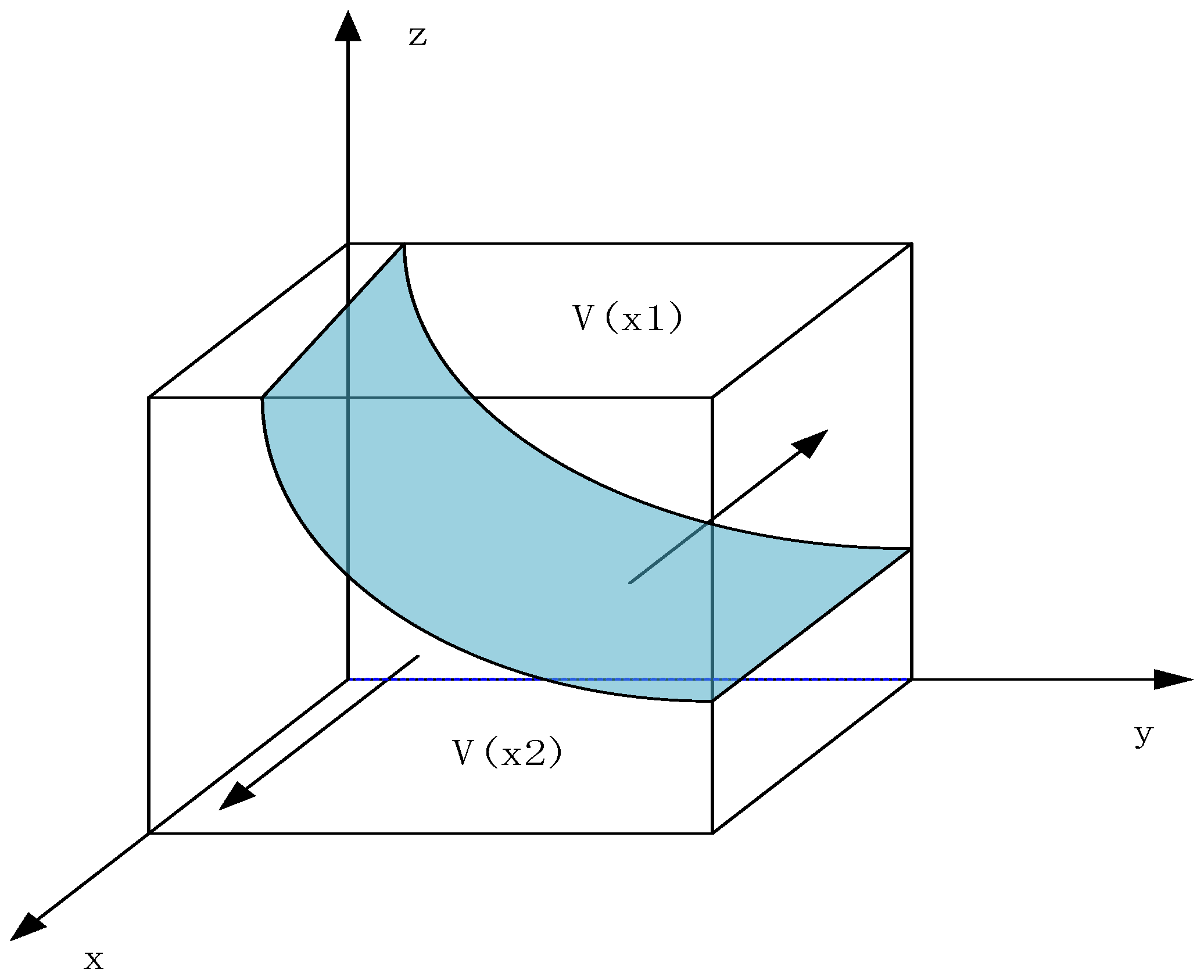
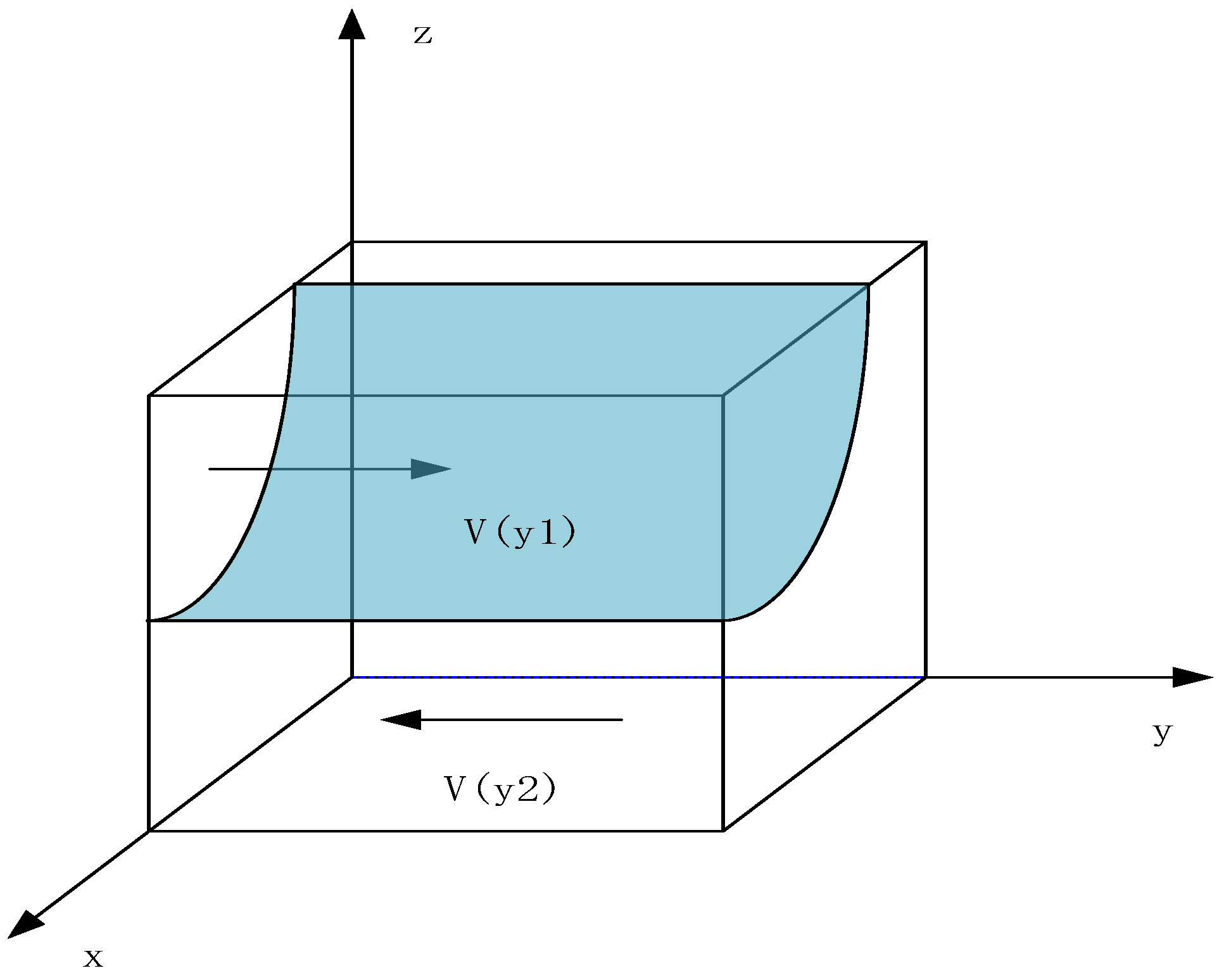
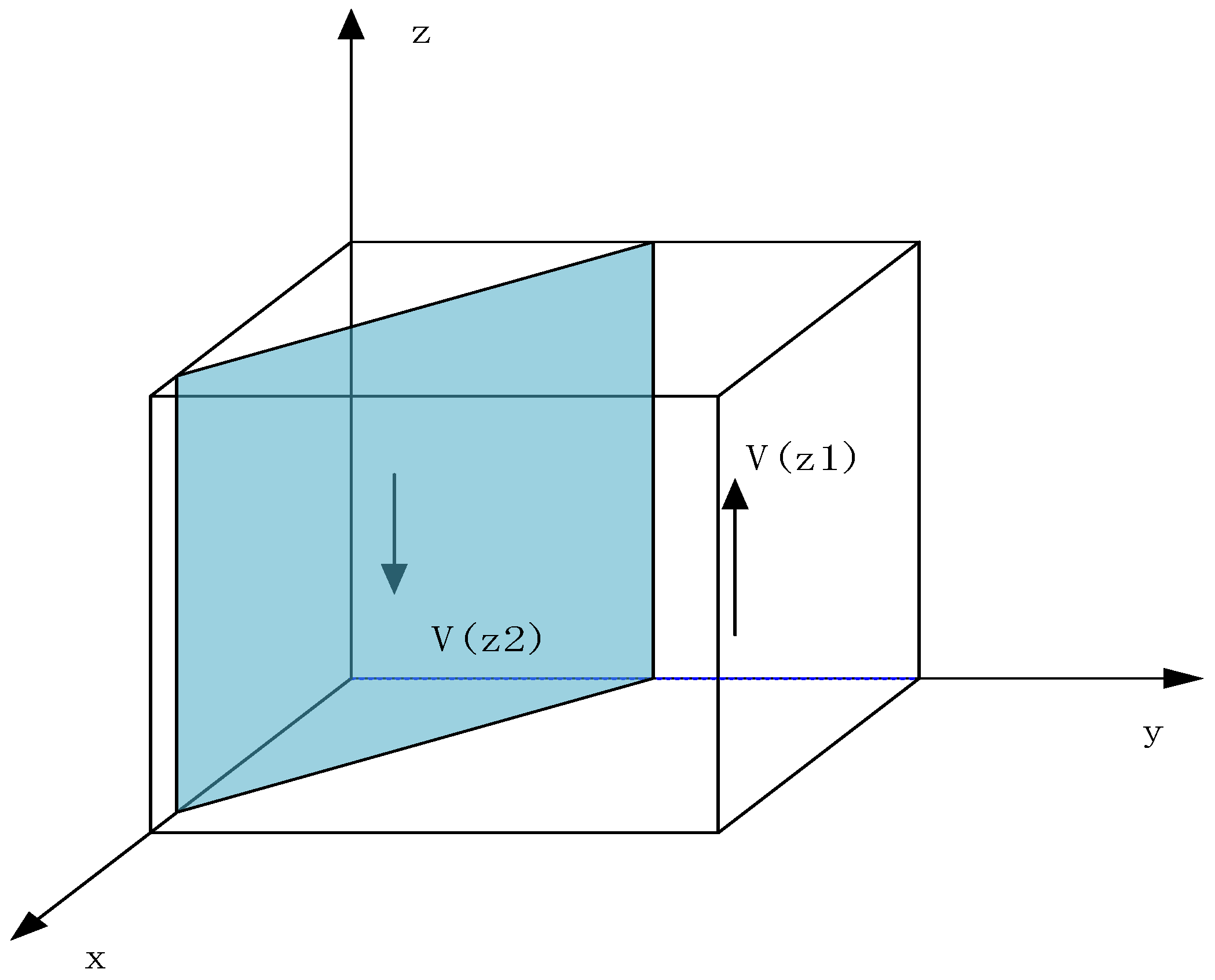


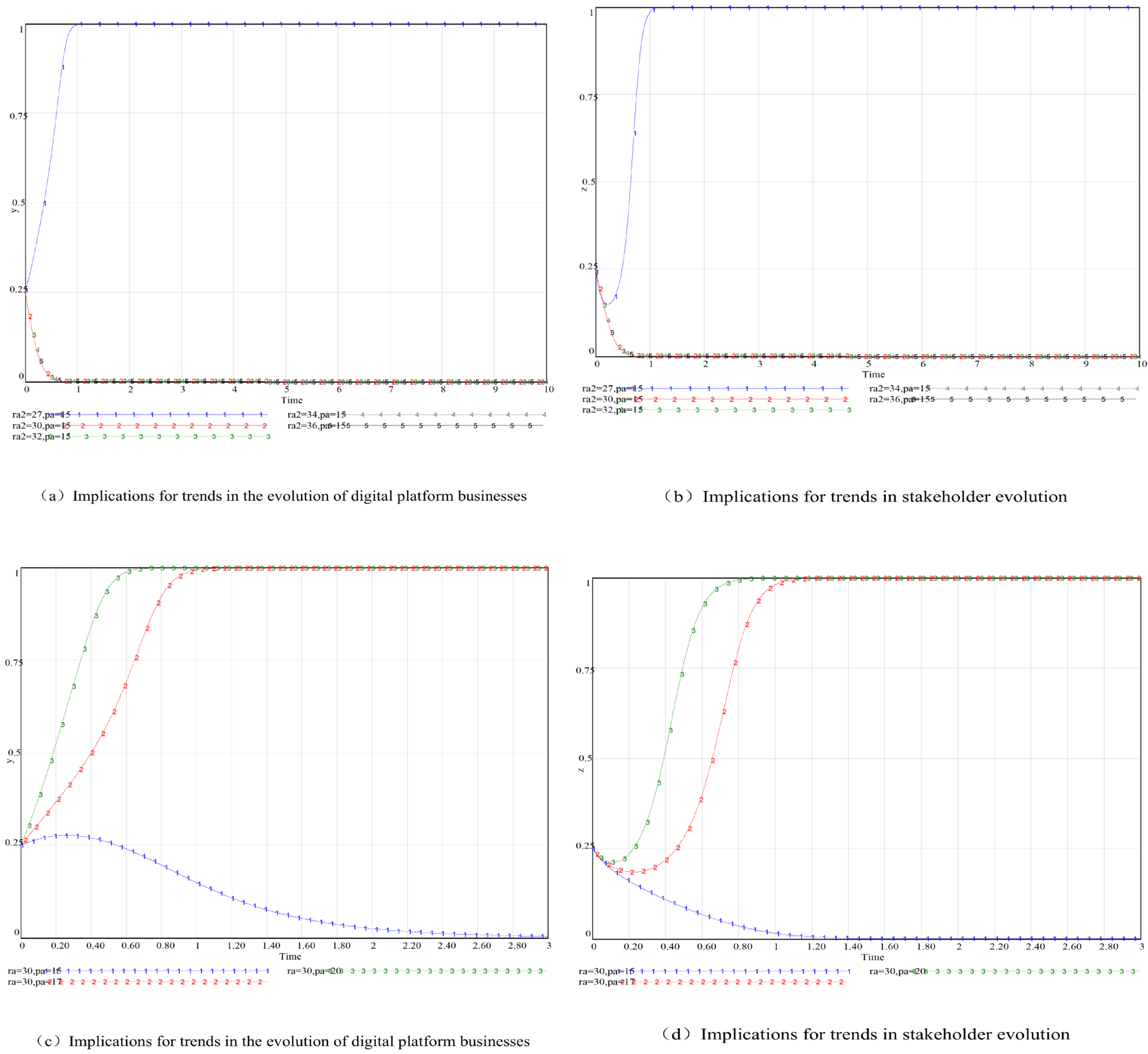


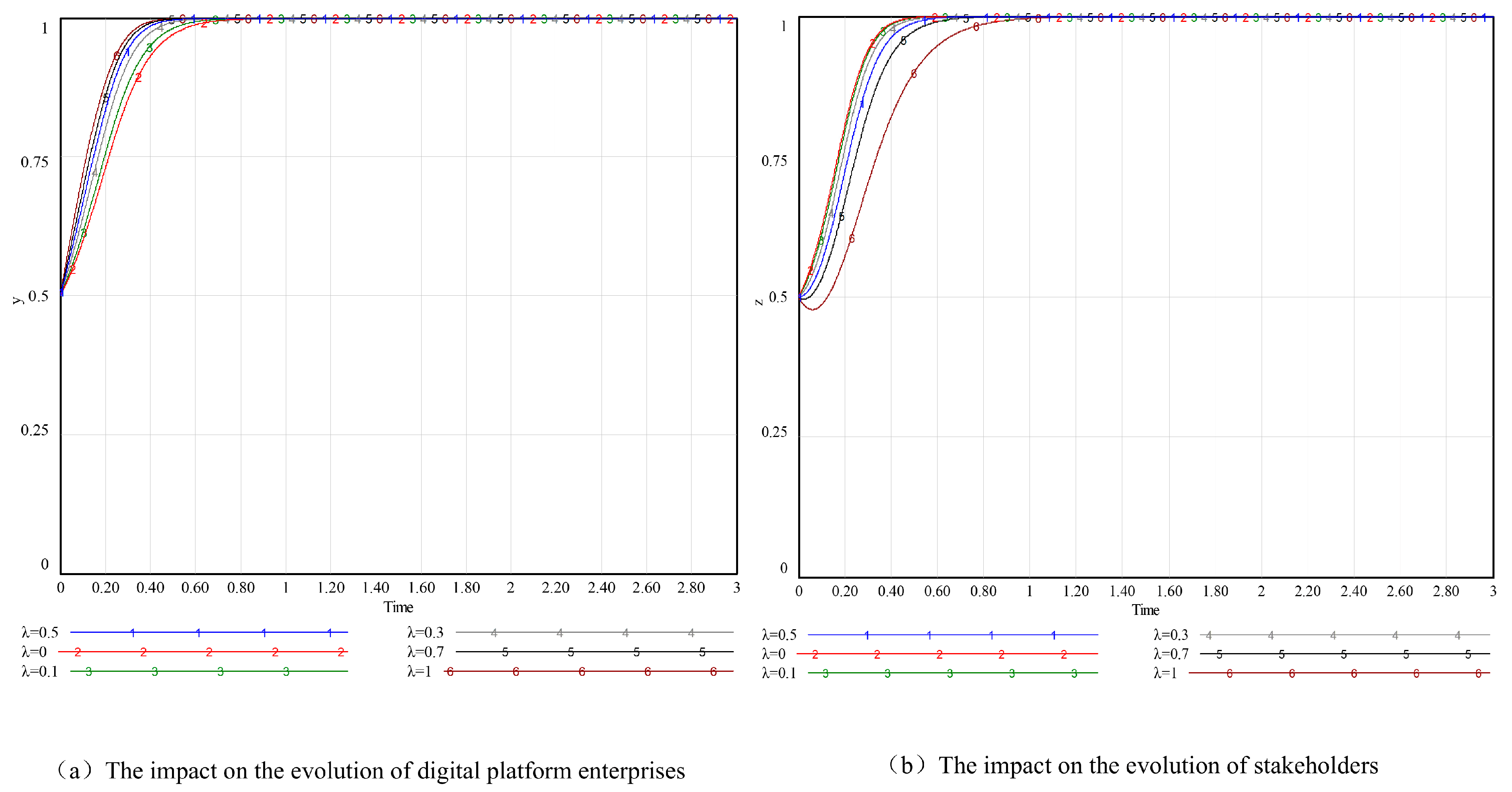
| Parameter | Description |
|---|---|
| The costs associated with proactive government regulation | |
| The positive social image benefits derived from effective government regulation | |
| Government support and subsidies for digital platform enterprises | |
| The government has failed to regulate effectively and has not recognized the social image losses caused by the misconduct of digital platform companies | |
| The costs associated with collaborative governance among digital platform enterprises | |
| The normal returns generated when digital platform enterprises actively engage in collaborative governance | |
| The benefits of cross-domain collaborative innovation between digital platform enterprises and stakeholders | |
| The distribution ratio of collaborative innovation benefits obtained by digital platform enterprises | |
| The costs associated with the governance of digital platform enterprises during instances of passive collaboration | |
| Excess returns of digital platform enterprises during negative collaborative governance | |
| The penalties faced by digital platform enterprises when non-compliance is detected by the government during instances of passive cooperation governance | |
| The costs associated with active stakeholder engagement | |
| The benefits of active stakeholder engagement | |
| The benefits of cross-domain collaborative innovation between stakeholders and digital platform enterprises | |
| The risk of losses resulting from the negative collaborative governance of digital platform enterprises by stakeholders | |
| The penalties faced by stakeholders when their passive participation is detected by the government | |
| Opportunity costs arising from stakeholder disengagement |
| Digital Platform Enterprise | Stakeholder | |||
|---|---|---|---|---|
| Active Participation (z) | Negative Participation (1 − z) | |||
| Government | Positive regulation () | Positive co-operative governance () | ||
| Negative co-operative governance () | ||||
| Lax regulation () | Positive co-operative governance () | |||
| Negative co-operative governance () | ||||
| Equilibrium Point | |||
|---|---|---|---|
| nexus point | |||
| Equilibrium Point | Stability Conditions | Outcome |
|---|---|---|
| Any conditions | Instability | |
| ESS | ||
| ESS | ||
| Any conditions | Instability | |
| Any conditions | Instability | |
| Any conditions | Instability | |
| ESS | ||
| ESS | ||
| Any conditions | Saddle point |
| Parameter | Description | Assignment | References |
|---|---|---|---|
| The costs associated with proactive government regulation | 15 | [53,54,55,56] | |
| The positive social image benefits derived from effective government regulation | 25 | ||
| Government support and subsidies for digital platform enterprises | 8 | ||
| The government has failed to regulate effectively and has not recognized the social image losses caused by the misconduct of digital platform companies | 8 | ||
| The costs associated with collaborative governance among digital platform enterprises | 16 | ||
| The normal returns generated when digital platform enterprises actively engage in collaborative governance | 19 | ||
| The benefits of cross-domain collaborative innovation between digital platform enterprises and stakeholders | 12 | ||
| The distribution ratio of collaborative innovation benefits obtained by digital platform enterprises | 0.5 | ||
| The costs associated with the governance of digital platform enterprises during instances of passive collaboration | 10 | ||
| Excess returns of digital platform enterprises during negative collaborative governance | 27 | ||
| The penalties faced by digital platform enterprises when non-compliance is detected by the government during instances of passive cooperation governance | 15 | ||
| The costs associated with active stakeholder engagement | 20 | ||
| Benefits of active stakeholder engagement | 15 | ||
| The risk of losses resulting from the negative collaborative governance of digital platform enterprises by stakeholders | 8 | ||
| The penalties faced by stakeholders when their passive participation is detected by the government | 5 | ||
| Opportunity costs arising from stakeholder disengagement | 7 |
Disclaimer/Publisher’s Note: The statements, opinions and data contained in all publications are solely those of the individual author(s) and contributor(s) and not of MDPI and/or the editor(s). MDPI and/or the editor(s) disclaim responsibility for any injury to people or property resulting from any ideas, methods, instructions or products referred to in the content. |
© 2025 by the authors. Licensee MDPI, Basel, Switzerland. This article is an open access article distributed under the terms and conditions of the Creative Commons Attribution (CC BY) license (https://creativecommons.org/licenses/by/4.0/).
Share and Cite
Tian, Z.; Zou, H.; Yang, S.; Hou, Q. Research on Collaborative Governance of Cross-Domain Digital Innovation Ecosystems Based on Evolutionary Game Theory. Systems 2025, 13, 558. https://doi.org/10.3390/systems13070558
Tian Z, Zou H, Yang S, Hou Q. Research on Collaborative Governance of Cross-Domain Digital Innovation Ecosystems Based on Evolutionary Game Theory. Systems. 2025; 13(7):558. https://doi.org/10.3390/systems13070558
Chicago/Turabian StyleTian, Zeyu, Hua Zou, Shuo Yang, and Qiang Hou. 2025. "Research on Collaborative Governance of Cross-Domain Digital Innovation Ecosystems Based on Evolutionary Game Theory" Systems 13, no. 7: 558. https://doi.org/10.3390/systems13070558
APA StyleTian, Z., Zou, H., Yang, S., & Hou, Q. (2025). Research on Collaborative Governance of Cross-Domain Digital Innovation Ecosystems Based on Evolutionary Game Theory. Systems, 13(7), 558. https://doi.org/10.3390/systems13070558





